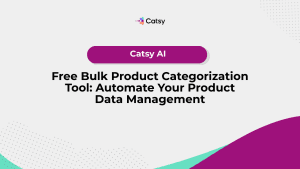Measuring PIM Success in Manufacturing: KPIs, ROI Metrics, and Performance Benchmarks
Implement the performance benchmarks outlined in this guide and you’ll be ready to measure your success and identify opportunities for improvement.

Introduction
Imagine it: Your manufacturing company just invested six figures in a Product Information Management (PIM) system. The developers promised streamlined operations and better data quality.
Now, fast forward six months – your CFO is asking the inevitable question: “Was it worth it?”
If you’re left scratching your head trying to answer that question, you’re not alone. Many businesses don’t know how to quantify PIM success in manufacturing. Simply put, traditional business metrics don’t capture the full value of improved data management.
The truth of the matter is that measuring PIM success goes far beyond just checking that the system is running. Instead, you must understand how your improved data impacts everything. From time-to-market to customer satisfaction, your data is critical.
Our guide will walk you through the essential KPIs, ROI metrics, and performance benchmarks that matter as you evaluate your PIM for manufacturing.
In this Article
Understanding PIM Success in Manufacturing Context
Before we dive into specific metrics, let’s take a peek at what PIM success actually looks like within a manufacturing environment.
The Unique Manufacturing Landscape
Manufacturing companies deal with complex product hierarchies. There are detailed tech specs, compliance requirements, and supply chain relationships.
For that reason, your PIM system doesn’t just manage product descriptions! It’s handling your bill of materials, technical drawing, supplier information, compliance certifications, and much more!
In this context, success means that your PIM effectively supports the whole product lifestyle, from engineering to end-of-life management. The right info must be available to the right teams at the right time.
Setting Realistic Expectations
One thing we’ve learned from working with manufacturing teams is that PIM benefits can take time. Imagine implementing a piece of production equipment. Improvements can be measured immediately. With PIM, though, the benefits compound over time.
Establish baseline measurements before implementation. You need to know where you started to accurately measure how far you’ve come.
Core KPIs for Manufacturing PIM Success
Let’s get into the metrics that really matter. We’ve organized these into categories that align with typical manufacturing priorities and business objectives.
Data Quality and Integrity Metrics
Data Completeness Rate This measures the percentage of required product attributes that are populated across your product catalog. In manufacturing, incomplete data can halt production lines or delay shipments.
Calculation: (Number of completed required fields / Total number of required fields) × 100
Data Accuracy Rate Track the percentage of product information that passes validation checks … without errors. This includes everything from dimensional specs to compliance certifications.
Calculation: (Number of accurate data records / Total number of data records) × 100
Data Consistency Score Measures how consistently the same information appears across different systems and touchpoints. For manufacturers with multiple ERP systems or regional databases, this is particularly critical.
💡 Pro Tip: Start with a baseline measurement before you implement a PIM. Many companies are surprised to discover their initial data completeness is below 60 percent, making the improvement trajectory even more impressive!
Operational Efficiency Metrics
Time-to-Market Reduction One of the most compelling benefits of effective PIM for manufacturing is faster product launches. Measure the time from product concept to market availability.
New Product Introduction (NPI) Cycle Time Track how long it takes to get new products fully set up across all systems and ready for production or sale.
Engineering Change Order (ECO) Processing Time Monitor how quickly product modifications flow through your systems.
Catalog Update Frequency Measure how often you are able to update and publish product information across all channels.
Process Improvement Metrics
Manual Data Entry Reduction Calculate the decrease in payroll hours spent on manual data entry and duplicate data management tasks.
Error Rate in Product Specifications Track the frequency of errors that impact production, quality, or customer satisfaction.
Cross-System Data Synchronization Time Measure how quickly changes in your PIM system propagate to ERP, MES, and other connected systems.
Make Catsy DAM and PIM Software an Extension of Your Team
Book a Free DemoROI Metrics That Matter to Manufacturing Leadership
Financial fluency is crucial when discussing PIM success. That’s particularly true when you’re talking to the C-Suite! Here are the ROI metrics that will resonate with your executives.
Direct Cost Savings
Reduced Labor Costs Calculate the hours saved through automation and improved efficiency, then multiply that number by your average hourly rates (including benefits).
Example calculation: If your team saves 10 hours per week on data management tasks at $50/hour fully loaded cost, that’s $26,000 annually per person.
Decreased Error-Related Costs Track the reduction in costs associated with specification errors. Include rework, scrap, warranty claims, and customer complaints.
Inventory Optimization Savings Better product data leads to improved demand forecasting and inventory management. Measure reductions in excess inventory and out of stock SKUs.
Revenue Enhancement Metrics
Faster Time-to-Revenue for New Products Calculate the additional revenue generated by enhanced time-to-market speeds.
Improved Quote Accuracy and Speed Track how PIM improvements affect your sales cycle length and quote-to-order conversion rates.
Cross-Selling and Upselling Improvements Better product relationships and recommendations can drive additional revenue per customer.
Indirect Value Metrics
Employee Productivity Gains Measure improvements in employee satisfaction and productivity when they can access accurate information quickly.
Customer Satisfaction Improvements Track how better product information affects customer satisfaction scores and retention rates.
Compliance and Risk Reduction Quantify the value of reduced compliance violations and associated penalties.
Performance Benchmarks and Industry Standards
How does your PIM performance compare to industry standards? Use this information to set realistic goals.
Industry Benchmark Ranges
Based on research and industry reports, here are typical performance ranges for manufacturing companies
Data Quality Benchmarks:
- Best-in-class manufacturers: 95-98 percent data completeness
- Industry average: 75-85 percent data completeness
- Below average: Less than 70 percent data completeness
Operational Efficiency Benchmarks:
- Time-to-market improvement: 15-40 percent reduction typical
- Engineering change processing: 50-70 percent faster typical
- Manual data entry reduction: 60-80 percent typical
ROI Timeline Expectations:
- Initial ROI realization: 6-12 months
- Full ROI achievement: 18-36 months
- Payback period: 12-24 months typical
Setting Your Own Benchmarks
Industry standards provide useful information, but your benchmarks should align with your business reality. Consider:
- Company size and complexity
- Number of products and SKUs
- Regulatory requirements
- Integration complexity
- Organizational change readiness
📊 Sidebar Example: A mid-size automotive parts manufacturer saw their data completeness improve from 68 to 94 percent within 18 months of PIM implementation. This resulted in a 25 percent reduction in quote preparation time and $2.3M in annual labor savings.
Implementing Your PIM Success Measurement Strategy
Having the right metrics is only half the battle – you need a systematic way to collect and analyze that data.
Phase 1: Baseline Establishment (Months 1-2)
Before you implement a PIM, establish baselines for each of your key metrics.
- Current data quality assessments
- Time studies for key processes
- Error rate documentation
- Cost tracking for manual processes
Phase 2: Implementation Monitoring (Months 3-12)
During the initial rollout, focus on these metrics that indicate progress:
- User adoption rates
- Data migration accuracy
- Process adherence
- Training completion rates
Phase 3: Performance Optimization (Months 13+)
Once you’ve fully implemented your PIM system, shift your focus to improvement!
- Regular data quality audits
- Process efficiency reviews
- ROI calculations and projections
- Benchmark comparisons
Creating Effective Dashboards
You need your strategy to be both actionable and visible. An effective PIM dashboard might include the following:
Executive View:
- High-level ROI metrics
- Key performance trends
- Business impact summaries
Operational View:
- Data quality metrics
- Process efficiency indicators
- System performance statistics
User View:
- Individual productivity metrics
- Data quality feedback
- Training and adoption progress
Common Pitfalls and How to Avoid Them
We’ve helped numerous manufacturing companies implement PIM systems. Here are the recurring challenges we’ve noticed, and how to avoid them.
Pitfall 1: Measuring Everything Instead of What Matters
While it’s tempting to track every possible metric, it’s just not practical. Avoid analysis paralysis by focusing on five to seven key metrics that directly tie to your business objectives.
Pitfall 2: Expecting Immediate ROI
PIM benefits will show themselves over time. Set realistic expectations and focus on leading indicators. Be patient!
Pitfall 3: Ignoring Baseline Measurements
Without baselines, you can’t measure your improvement. Invest time upfront to establish these baseline metrics.
Pitfall 4: Focusing Only on System Metrics
Balance your technical metrics like system uptime with your business impact measures to get a complete picture.
Pitfall 5: Not Involving End Users in Measurement
Don’t ignore team input! These employees use your PIM system daily – heed their advice regarding the system’s effectiveness.
Tools and Technologies for PIM Success Measurement
Measurement of your PIM success is only possible with the right tools.
Built-in PIM Analytics
Most modern PIM platforms include analytics capabilities that can track:
- Data quality metrics
- User activity and adoption
- System performance indicators
- Content publishing statistics
Business Intelligence Integration
Connecting your PIM metrics to your existing business intelligence platforms allows for:
- Cross-system analysis
- Advanced reporting capabilities
- Automated dashboard updates
- Historical trend analysis
Third-Party Monitoring Tools
Specialized tools can provide additional insights into:
- Data quality across systems
- Process performance monitoring
- User experience analytics
- Compliance tracking
🔧 Implementation Note: Begin with your PIM’s built-in analytics before you purchase additional tools. Many companies find that these are sufficient for their business’s needs.
Future-Proofing Your PIM Measurement Strategy
Your manufacturing business will grow and your operations will evolve. Your approach to measuring PIM success should be dynamic, too!
Emerging Trends to Watch
AI-Driven Data Quality:
More and more, AI is being used to detect and correct data quality issues. While still fallible, this can be a game changer for your data integrity.
Real-Time Analytics:
There is a shift toward real-time decision making. That means your PIM metrics need to be available instantly. Don’t rely on monthly reports.
Sustainability Metrics:
Customers (and distributors) want to know about your product’s environmental impact. Many PIM systems can help you track this.
Digital Twin Integration:
As digital twins become more prevalent in manufacturing, PIM systems will play a crucial role in managing the product information that feeds these models.
Adapting Your Measurement Approach
To future-proof your measurement strategy:
- Build flexibility into your metrics framework – Choose metrics that can evolve with your business needs
- Invest in scalable measurement tools – Ensure your analytics infrastructure can grow with your business
- Stay connected to industry trends – Regularly review and update your benchmark targets
- Plan for integration expansion – Consider how new systems and technologies will impact your measurement needs
Conclusion
Measuring PIM success in manufacturing isn’t just about proving ROI to executives. (That certainly helps, though.) Instead, it’s about creating a culture of continuous improvement.
Begin with clear objectives, establish solid baselines, and focus on the metrics that are important to your business. Remember that PIM success is a journey, not a destination.
By implementing the steps outlined in this guide, you’ll be well-equipped to demonstrate the value of your PIM investment… and identify opportunities for continuous improvement. More importantly, you’ll have the insights needed to make your PIM system a true competitive advantage in today’s data-driven manufacturing landscape.
Want more tips, tutorials, and insights on product content and e-commerce operations?
Stay connected. We post regularly to help brands like yours scale smarter.
Are You Ready To streamline your product content management?
Subscribe For More Content
Sign up for monthly tips on how to drive revenue with product content.




